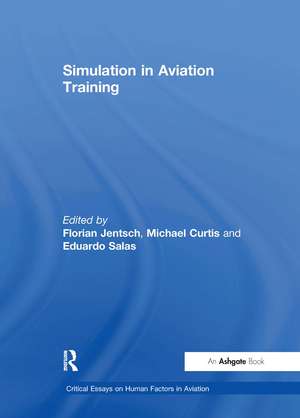Simulation in Aviation Training: Critical Essays on Human Factors in Aviation
Autor Florian Jentsch, Michael Curtisen Limba Engleză Hardback – 18 mar 2011
Preț: 1585.31 lei
Preț vechi: 2128.28 lei
-26% Nou
Puncte Express: 2378
Preț estimativ în valută:
303.35€ • 317.52$ • 252.48£
303.35€ • 317.52$ • 252.48£
Comandă specială
Livrare economică 10-24 martie
Doresc să fiu notificat când acest titlu va fi disponibil:
Se trimite...
Preluare comenzi: 021 569.72.76
Specificații
ISBN-13: 9780754628873
ISBN-10: 0754628876
Pagini: 540
Dimensiuni: 174 x 246 x 41 mm
Greutate: 1.22 kg
Ediția:1
Editura: CRC Press
Colecția Routledge
Seria Critical Essays on Human Factors in Aviation
ISBN-10: 0754628876
Pagini: 540
Dimensiuni: 174 x 246 x 41 mm
Greutate: 1.22 kg
Ediția:1
Editura: CRC Press
Colecția Routledge
Seria Critical Essays on Human Factors in Aviation
Cuprins
Contents: Introduction; Part I Using Simulation for Training: Aircraft simulation and pilot training, Paul W. Caro; Adopting the instructional science paradigm to encompass in virtual environments, D. Dorsey, G. Campbell and S. Russell; It's not how much you have but how you use it: toward a rational use of simulation to support aviation training, Eduardo Salas, Clint A. Bowers and Lori Rhodenizer; Rapidly reconfigurable event-set based line operational evaluation scenarios, Clint Bowers, Florian Jentsch, David Baker, Carolyn Prince and Eduardo Salas; Simulation design for training and assessment, Stephen Alessi. Part II Simulation Fidelity: Quality criteria for simulator images: a literature review, Pieter Padmos and Maarten V. Milders; Transfer of skill from a computer game trainer to flight, Daniel Gopher, Maya Weil and Tal Bareket; Evidence for the validity of PC-based simulations in studying aircrew coordination, Florian Jentsch and Clint A. Bowers; Fidelity and validity of simulator training, N. Dahlstrom, S. Dekker, R. van Winsen and J. Nyce. Part III Physiological Responses and Simulation Sickness: A literature survey for virtual environments: military flight simulator visual systems and simulator sickness, Randy Pausch, Thomas Crea and Matthew Conway; Simulator sickness is polygenic and polysymptomatic: implications for research, Robert S. Kennedy and Jennifer E. Fowlkes; Simulator platform motion: the need revisited, Judith Bürki-Cohen, Nancy N. Soja and Thomas Longridge. Part IV Simulation as Training and Method: Training high-performance skills: fallacies and guidelines, Walter Schneider; Part-task training for tracking and manual control, Dennis C. Wightman and Gavan Lintern; Transfer of landing skills in beginning flight training, Gavan Lintern, Stanley N. Roscoe, Jefferson M. Koonce and Leon D. Segal; Individual and team decision making under stress: theoretical underpinnings, Janice A. Cannon-Bowers and Eduardo Salas; Evaluating the effectiveness of flight simulators for training combat skills: a review, Herbert H. Bell and Wayne L. Waag. Part V Training Evaluation Using Simulation: Training effectiveness evaluation, R.T. Hays and M.J. Singer; The reliability of instructor evaluations of crew performance: good news and not so good news, Michael T. Brannick, Carolyn Prince and Eduardo Salas; Continuous concurrent feedback degrades skill learning: implications for training and simulation, Richard A. Schmidt and Gabriele Wulf; Performance measurement in simulation-based training: a review and best practice, Eduardo Salas, Michael A. Rosen, Janet D. Held and Johnny J. Weissmuller. Part VI Simulation Beyond Aviation: The use of simulation for training teamwork skills in health care: how low can you go?, J.M. Beaubien and D.P. Baker; The complexity of team training: what we have learned from aviation and its application to medicine, W.R. Hamman; Constructs of simulation evaluation, Andrew Hale Feinstein and Hugh M. Cannon; Games, motivation and learning: a research and practice model, Rosemary Garris, Robert Ahlers and James E. Driskell; Name index.
Notă biografică
Florian Jentsch, Michael Curtis and Eduardo Salas, University of Central Florida, USA
Descriere
Simulations have been a fixture of aviation training for many years. Advances in simulator technology now enable modern flight simulation to mimic very closely the look and feel of real world flight operations. In spite of this, responsible researchers, trainers, and simulation developers need to look beyond mere simulator fidelity to produce meaningful training outcomes. Optimal simulation training development can unquestionably benefit from knowledge and understanding of past, present, and future research in this topic area. As a result, this volume of key writings is invaluable as a reference, to help guide exploration of critical research in the field. By providing a mix of classic articles that stand the test of time, and recent writings that illuminate current issues, this volume informs a broad range of topics relevant to simulation training in aviation.




